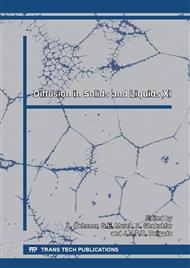p.48
p.53
p.59
p.65
p.71
p.77
p.83
p.89
p.95
Fabrication of Micro-Lens Array Obtained by Anisotropic Wet Etching of Silicon
Abstract:
This paper presents the fabrication of a micro-lens array surface with a single-mask process and two etching steps with KOH water solution. Numerical analysis of optics was used to determine the optimal design parameters such as curvature sagitta and radius. The dimension of each lens is 20μm x 20μm. We used anisotropic etching of <100> silicon through a circular and squar mask to produce a pyramidal pit formed by four (111) planes. The oxide mask is stripped and the immersion of the sample in the etchant solution favors the etching of (411) plane transforming the pit into a smooth hemispherical cavity. An intermediate stage exists when a wider 19.470 <411> - face pyramid replaces the initial 54.740 inverted pyramid. The dependence of surface roughness on concentration and temperature of KOH is investigated in the range of 25%-40% and 60°C-80°C, respectively, and compared between them. The surface profiles and roughness was characterized by AFM. The etching depth and radius of micro-lens array was obtained from the SEM images and AFM data. Also, the array of concave depressions was directly used as a mould for replication of KER-2500 transparent polymeric silicon from Shin-Etsu with a refractive index n=1.41. The perfectly matched array of micro-lenses can be detached from substrate and used as a local solar concentrator. Optical properties such as the focal length of the plano-convex micro-lens array, obtained by replication, are measured and analyzed.
Info:
Periodical:
Pages:
71-76
Citation:
Online since:
July 2016
Price:
Сopyright:
© 2016 Trans Tech Publications Ltd. All Rights Reserved
Share:
Citation:


